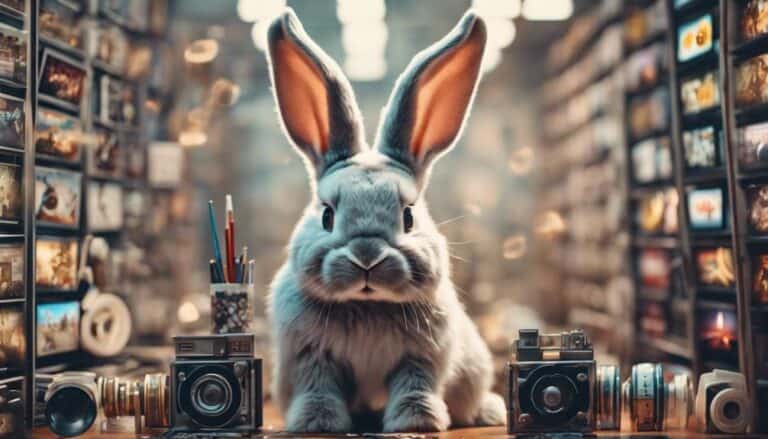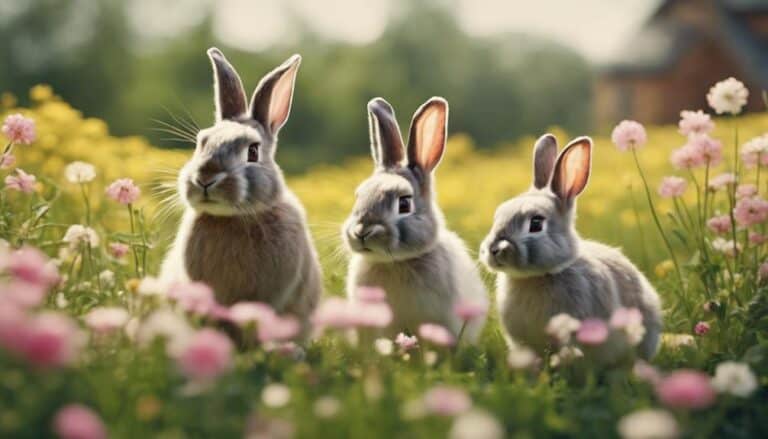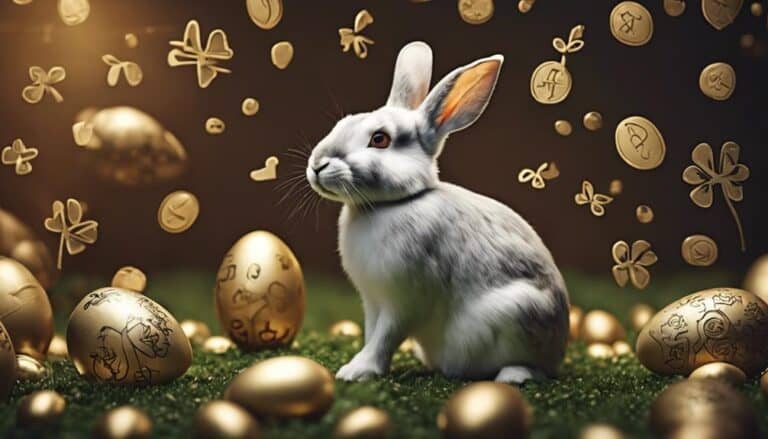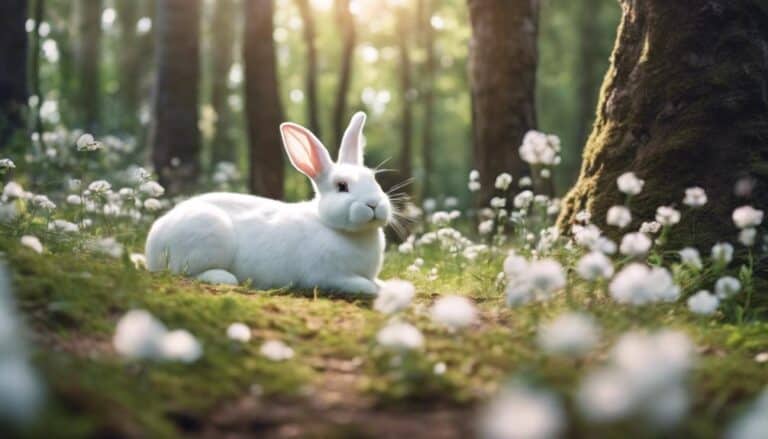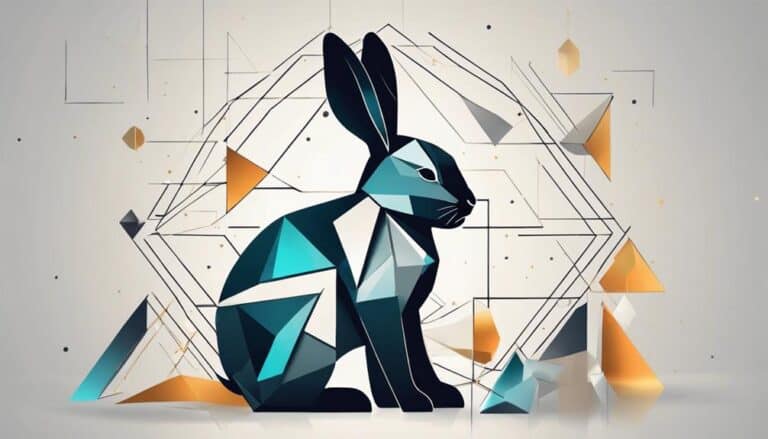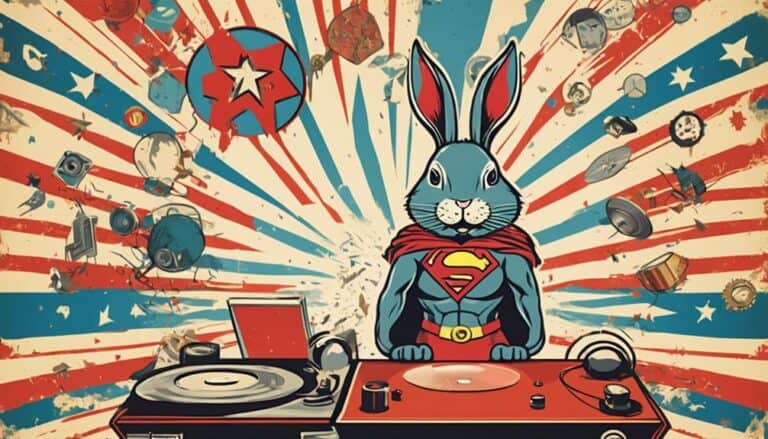As you hop through the corridors of art history, you'll find that rabbits and hares have left their mark on the canvas in more ways than one. From ancient civilizations to modern-day masterpieces, these furry creatures have symbolized a variety of themes and emotions in art.
But what exactly do these whiskered wonders represent, and how have artists across time and cultures interpreted their significance on the canvas? Find out how these elusive creatures have captivated the artistic imagination and continue to inspire awe and curiosity in the world of art.
Contents
Key Takeaways
- Rabbits symbolize rebirth, fertility, and abundance in art across cultures.
- Rabbit imagery reflects profound themes of life, death, and rebirth.
- Artists use rabbits as versatile allegorical figures to engage viewers.
- Rabbit art evolves, mirroring cultural shifts and inspiring various artistic movements.
Bunny Symbolism and Cultural Significance
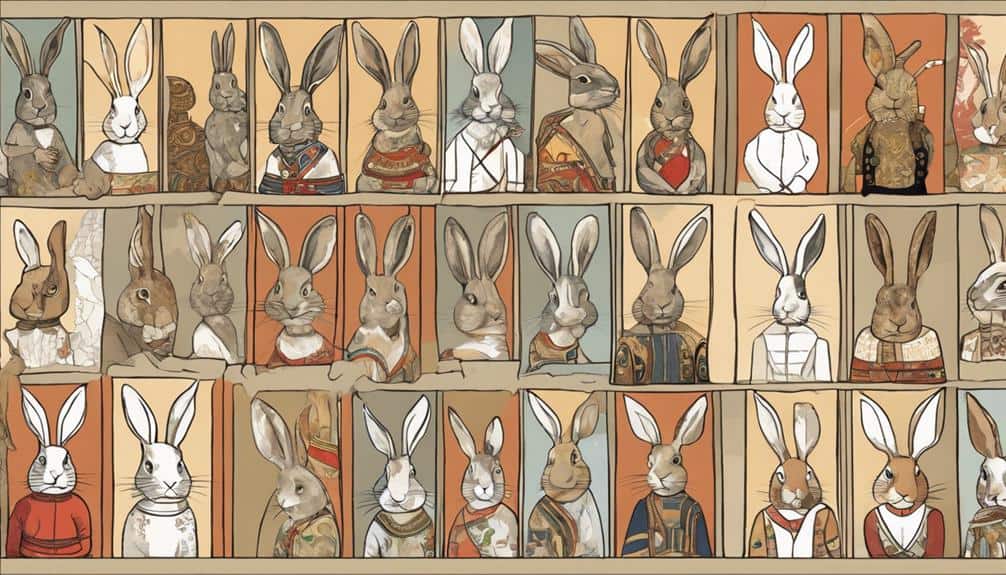
In various cultures throughout history, rabbits have symbolized rebirth and fertility, holding significant cultural importance. The prolific breeding habits of rabbits have been associated with fertility and new beginnings. This symbolism is evident in the visual arts, where rabbits are often depicted in scenes of abundance and growth, emphasizing their link to fecundity. The representation of rabbits in art serves as a visual metaphor for the cycle of life, death, and rebirth.
The intricate scrolls created by artists like Nozaki Shinichi beautifully capture the essence of rabbits in connection to the moon. These depictions highlight the celestial significance of rabbits, showcasing their role in symbolizing renewal and the cyclical nature of existence. Through the lens of visual arts, rabbits are portrayed as creatures of fertility and regeneration, embodying the enduring themes of rebirth and continuity that have permeated various cultures throughout history.
Historical Depictions of Rabbits in Art
Pivoting from the symbolism of rabbits in art as a representation of rebirth and fertility, historical depictions of rabbits in art reveal intricate narratives that challenge perceptions and provoke critical thought. William Hogarth, a prominent artist of the 18th century, utilized rabbits in his artwork 'Credulity, superstition and fanaticism' to satirize gullibility prevalent in society. Through his clever use of imagery, Hogarth commented on themes of credulity and superstition, shedding light on the societal issues of his time.
Another historical figure linked to the portrayal of rabbits in art is Mary Toft, known for her infamous hoax involving false claims of giving birth to rabbits. Toft's deception not only led to the European symbolism linking rabbits with fertility but also resulted in ridicule and scrutiny. This episode in history showcases how the depiction of rabbits in art can be intertwined with themes of deception and the consequences that follow. Hogarth and Toft's stories exemplify how historical depictions of rabbits in art have been used to convey complex narratives and critique societal norms.
Evolution of Rabbit Imagery in Art
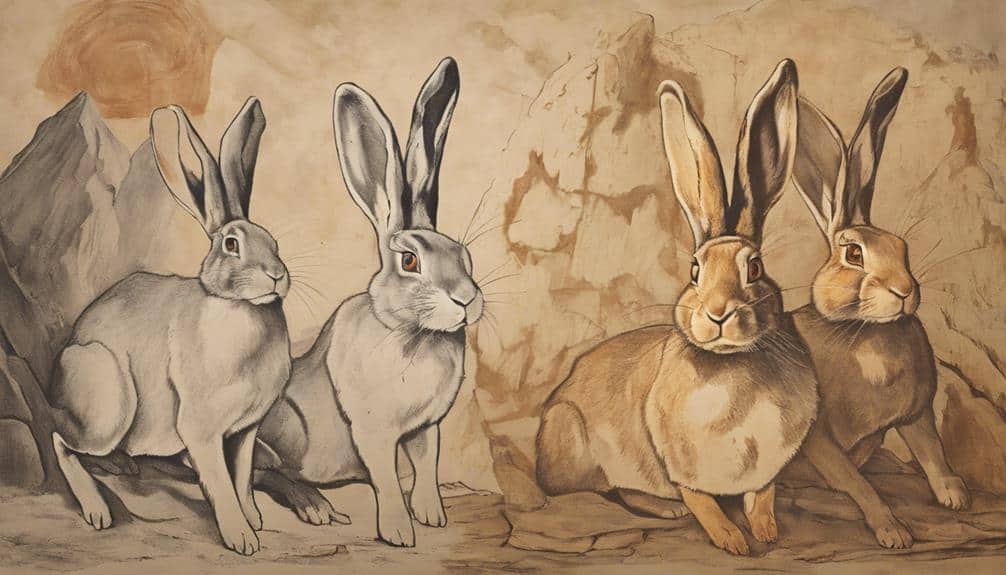
As you explore the evolution of rabbit imagery in art, consider the shift from early depictions of rabbits as symbols of rebirth and fertility to their modern interpretations.
Artists have reimagined rabbit symbolism, reflecting changes in cultural contexts and artistic trends. Analyzing how these interpretations have evolved can provide insights into the enduring significance of rabbits in art.
Early Rabbit Depictions
During the ancient times, rabbit depictions in art trace back to as early as 1000 BC in Chinese decorations, showcasing the beginnings of the evolution of rabbit imagery in artistic expressions.
Over the centuries, artists like Albrecht Dürer have contributed considerably to the history of European rabbit art, portraying these creatures in various styles from naturalistic to stylized representations.
These early artworks not only reflect cultural preferences and artistic trends but also serve as a foundation for the symbolic significance rabbits hold in different cultures.
The intricate details and interpretations of rabbits in art have evolved over time, mirroring shifting societal beliefs and artistic movements while maintaining the enduring presence of these animals in artistic expression.
Symbolism in Art
Throughout the evolution of artistic expressions, rabbit imagery has transformed into a symbol rich in connotations of rebirth and fertility, resonating across cultures and artistic styles. Small animals like rabbits are often depicted in art giving birth or surrounded by symbols of fertility, representing the cycle of life and renewal.
Artists such as Albrecht Dürer and Jan Weenix have portrayed rabbits in various contexts, adding layers of meaning to their works. The symbolism of rabbits in art has transcended mere representation, embodying deeper themes of growth, abundance, and new beginnings.
Across different cultures, the image of rabbits has been imbued with diverse mythological and spiritual significance, reflecting the universal themes of birth and regeneration that these creatures symbolize.
Modern Rabbit Interpretations
The evolution of rabbit imagery in modern art showcases a dynamic range of styles, from realistic to abstract representations. Artists explore contemporary themes such as environmental concerns and social issues through their rabbit interpretations.
Nature studies play a significant role in these modern depictions, portraying rabbits within their natural habitats or interacting with other elements in the environment. Additionally, rabbits are often used symbolically, representing resilience, adaptability, and cultural commentary in the works of contemporary artists.
The use of rabbits as gifts in art symbolizes generosity, innocence, and the cyclical nature of life. The evolution of rabbit imagery also incorporates digital and multimedia formats, reflecting technological advancements and pushing the boundaries of traditional artistic expressions.
Religious Symbolism of Rabbits in Art
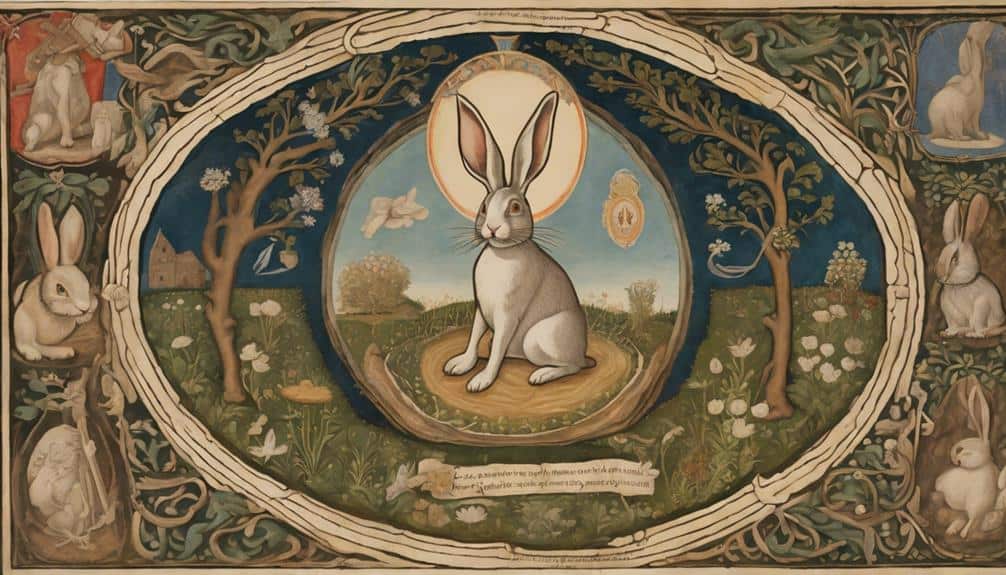
In various religious traditions, rabbits in art convey profound symbolic meanings that reflect core beliefs and values. In Christian art, the rabbit symbolizes fertility, embodying themes of abundance and new life. This imagery ties into the idea of rebirth and renewal, especially during the season of Easter.
Conversely, hares in pagan traditions represent rebirth, symbolizing regeneration and the cyclical nature of life. In Buddhist art, the rabbit signifies humility and selflessness, emphasizing the importance of modesty and service to others.
Islamic art uses the image of a rabbit to symbolize timidity and gentleness, highlighting the virtues of meekness and peace. Hindu art depicts the rabbit as a symbol of cleverness and resourcefulness, often appearing in various mythological stories as a figure of intelligence and quick thinking.
Through these diverse interpretations, rabbits and hares in religious art serve as powerful symbols that enrich the spiritual narratives and teachings of different faith traditions.
Rabbits as Allegorical Figures in Art
In art, rabbits as allegorical figures carry rich symbolism, often representing concepts like fertility, rebirth, and the eternal cycle of life. Artists leverage these symbolic meanings to convey deeper messages, adding layers of interpretation to their artworks.
The allegorical portrayal of rabbits in art serves as a powerful tool to explore themes of renewal, regeneration, and the enduring passage of time.
Symbolism in Rabbit Art
Exploring the intricate layers of symbolism in rabbit art reveals how artists ingeniously convey profound themes of fertility, rebirth, and cunningness through these allegorical figures. In various cultural contexts, rabbits symbolize different virtues and qualities.
For instance, in some cultures, rabbits represent agility and quick thinking, while in others, they symbolize abundance and prosperity due to their prolific breeding habits. The use of rabbits as allegorical figures allows artists to explore the cyclical nature of life, emphasizing themes of renewal and growth.
Meaning Behind Rabbits
Rabbit art intricately weaves symbolism depicting fertility, rebirth, and the cyclical nature of life, utilizing these allegorical figures to convey profound themes and metaphors in artistic expressions.
Rabbits and hares aren't merely cute creatures but serve as powerful symbols in art, representing transformation, growth, and renewal. Through their portrayal as playful, cunning, and mysterious beings, artists tap into the rich symbolism associated with rabbits to communicate deeper meanings.
The symbolism of rabbits in art is deeply rooted in cultural beliefs, mythological interpretations, and religious significance, making them versatile allegorical figures. By incorporating rabbits into their artworks, artists engage viewers in contemplation of the interconnected themes of life, death, and rebirth, fostering a deeper understanding of the cyclical nature of existence.
Impact of Rabbits on Artistic Movements
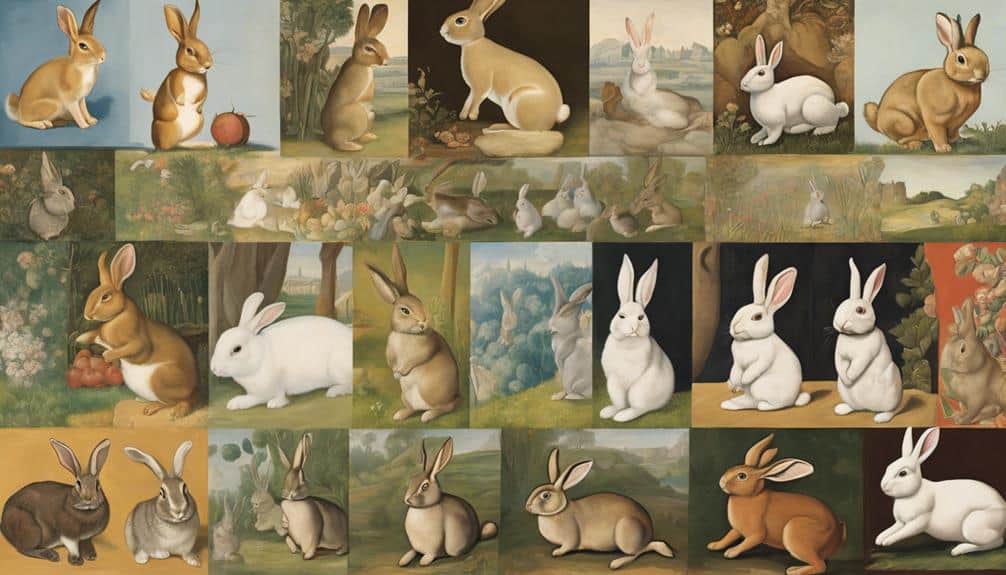
Rabbits' influence on various artistic movements is undeniable, as their symbolism of rebirth and fertility has left a lasting impact on the evolution of art history. From the iconic white rabbit in Lewis Carroll's 'Alice's Adventures in Wonderland' to the idea of rabbits representing prosperity in Chinese culture, these creatures have inspired artists across centuries.
Notable figures like Albrecht Dürer and Jan Weenix have immortalized rabbits in their works, emphasizing their significance in art. The evolution of rabbit and hare artworks mirrors cultural shifts, with Surrealist, pop art, and installation artists reimagining these symbols in innovative ways.
Frequently Asked Questions
What Is the History of the Rabbit in Art?
Explore the rich tapestry of rabbit representation in art. Witness the evolution of this symbol, from ancient fertility motifs to modern abstract interpretations. Investigate the artistic evolution that mirrors societal beliefs and cultural shifts.
What Is the Historical Significance of the Rabbit?
In art, rabbits hold historical significance through their deep-rooted symbolism. Artists have portrayed them to represent fertility, rebirth, and crucial, bridging cultural interpretations. Their artistic representation transcends time, embodying diverse meanings across different mythologies and religions.
What Is the Symbolism of Rabbits?
In art, rabbits symbolize various themes like rebirth, fertility, and cunningness. Folklore often portrays them as tricksters, reflecting their complex symbolism. They are integral in cultural narratives, embodying both innocence and deviousness.
What Is the Cultural Significance of the Rabbit?
Explore the rabbit's cultural significance through its symbolism of rebirth and fertility, inspiring various artistic interpretations. Investigate how this creature embodies the cyclical nature of life, serving as a beacon of new beginnings.
Conclusion
As you reflect on the rich history of rabbit symbolism in art, consider this intriguing statistic: the iconic Hare by Albrecht Dürer, created in 1502, remains one of the most reproduced prints in art history.
With over 30,000 impressions made from the original woodcut, this enduring image serves as a proof to the lasting impact and significance of rabbits in artistic expression throughout the centuries.

